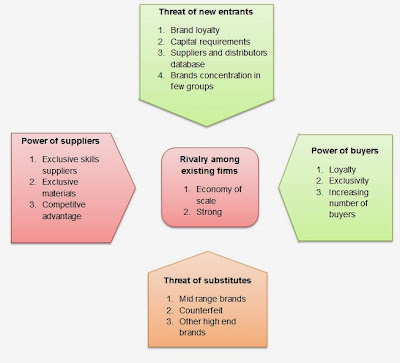For us it's something beyond it! We can see through the brand. Let me tell you a secret, that was discovered by Michael Poter. It's called Poter's 5 forces and it's a tool that shapes strategies of every company in every industry.
Porters model of competitive forces assumes that there are five competitive forces that identify the competitive power in a business situation can be used as a tool to assess a company’s position in its industry. These five competitive forces are:
- Threat of substitute products
- Threat of new entrants
- Competitive rivalry within the industry
- Bargaining power of suppliers
- Bargaining power of buyers
So let's look in details how these forces influence the activity of Bvlgari and Chopard (and their competitors-check out previous posts).
Rivalry among existing firms is extremely HIGH in this type of industry:
- Economy of scale: a few large groups dominate.
- Strong brands: image of every brand was thought over (ex. Carla Bruni in the advertising campaign of Bvlgari) in accordance with brand heritage (Chopard's magic was embodied in Disney collection).
Threat of new
entrants should be considered as LOW, because of the following barriers:
- Brand loyalty: luxury brands as Bvlgari and Chopard have extremely loyal customers, that are obsessed with specific brand and don't want to change their preferences.
- Capital requirements: investments to build a new luxury jewelry brand are huge and unrecoverable in case of failure.
- Suppliers and distributors databases: it is hard to get in touch with suppliers that protect competitive advantage of brands they supply to. Top level distributors will not deal with new unknown companies in order not to damage their reputation.
- Brands concentration in few groups: almost all luxury brands are own by big groups. Bvlgari is a part of LVMH and Chopard represents a giant group itself. Small new companies will not be able to compete with such luxury monsters.
Threat of substitutes is at the MODERATE level too.
- Mid range brands that pretend to be premium. For example, everybody knows Place Vendôme in Paris where are almost all luxury brands located. A bit further from this place there is a shop of Maty jewelry that is not high end brand, but due to the location could be considered by people as part of Place Vendôme community.
- Counterfeit: could be a serious threat to Bvlgari and Chopard (not only in terms of watchmaking, people also buy fake wedding bands with Bvlgari logo on them).
- Other luxury brands, that gives the same feeling of belonging to the nobility (Hermes bags or Louboutin shoes).

Power of suppliers is from MODERATE to HIGH due to the following reasons:
- Exclusive skills suppliers: Both Bvlgari and Chopard have strong commitment to quality and propose unique style of their jewelry. It could be hard to make big list of suppliers, that can support them in their engagements.
- Exclusive materials (b.zero collection of Bvlgari and Happy diamonds of Chopard).
- Competitive advantage: suppliers are acquired to protect it outright.
Buyers don't have a strong bargainig power, that's why this force is LOW.
- Loyalty: customers emotionally attached to the brand.
- Exclusivity: unique products that are considered as masterpieces (collection of Bvlgari jewelry that belonged to Elizabeth Taylor).
- Increasing number of buyers: wealthy people from China and other asian countries.
So "may the force be with you".
Kristina Voskivarova
Sources:
1. http://hbr.org/2008/01/the-five-competitive-forces-that-shape-strategy/
2. http://www.notesdesk.com/notes/strategy/porters-five-forces-model-porters-model/
3, http://s3images.coroflot.com/user_files/individual_files/500267_H_jxIO2eTaViTyLAB_HuQdS8I.pdf
4. http://prezi.com/ms7_bvysprei/corporate-strategy-luxury-industry/
5. http://fr.slideshare.net/vy1230/luxury-goods-industry-analysis-2013
6. http://fr.slideshare.net/mraldang/louis-vuttion-moet-henness
7. http://www.blog-bisontin.fr/?2012/01/01/34-maty-bijoux
8. http://diary.chopard.com/the-enchanting-disney-princess-collection
3, http://s3images.coroflot.com/user_files/individual_files/500267_H_jxIO2eTaViTyLAB_HuQdS8I.pdf
4. http://prezi.com/ms7_bvysprei/corporate-strategy-luxury-industry/
5. http://fr.slideshare.net/vy1230/luxury-goods-industry-analysis-2013
6. http://fr.slideshare.net/mraldang/louis-vuttion-moet-henness
7. http://www.blog-bisontin.fr/?2012/01/01/34-maty-bijoux
8. http://diary.chopard.com/the-enchanting-disney-princess-collection



No comments:
Post a Comment